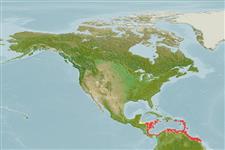Teleostei (teleosts) >
Ophidiiformes (Cusk eels) >
Ophidiidae (Cusk-eels) > Ophidiinae
Etymology: Lepophidium: Latin, lepus, leporis = rabbit + Greek, ophis = serpent (Ref. 45335).
More on author: Robins.
Environment: milieu / climate zone / depth range / distribution range
Ecology
Marine; demersal; depth range 46 - 186 m (Ref. 91765). Tropical; 18°N - 4°N, 88°W - 51°W (Ref. 91765)
Western Central Atlantic: Caribbean Sea, from Honduras to Trinidad and along the Atlantic Coast of northern South America, to at least as far as French Guiana.
Size / Weight / Age
Maturity: Lm ? range ? - ? cm
Max length : 18.9 cm SL male/unsexed; (Ref. 91765); common length : 14.0 cm TL male/unsexed; (Ref. 5217)
Short description
Identification keys | Morphology | Morphometrics
Dorsal soft rays (total): 106 - 115; Anal soft rays: 92 - 100; Vertebrae: 62 - 66. Rostral spine long and curved, reaching tip of snout, without vertical basal component; peritoneum pale; no median basibranchial tooth patch; head extensively covered with imbricate rows of cycloid scales except for snout and throat; body tapering to point, dagger-shaped (Ref. 34024).
Uncommon species (Ref. 34024). Found on the continental shelf, on soft bottoms (Ref. 5217). Oviparous, with oval pelagic eggs floating in a gelatinous mass (Ref. 205). Consumed fresh (Ref. 5217).
Life cycle and mating behavior
Maturities | Reproduction | Spawnings | Egg(s) | Fecundities | Larvae
Robins, C.R., R.H. Robins and M.E. Brown, 2012. A revision of Lepophidium (Teleoastei, Ophidiidae), with descriptions of eight new species. Bulletin of the Florida Museum of Natural History 52(1):1-94. (Ref. 91765)
IUCN Red List Status (Ref. 130435)
Threat to humans
Harmless
Human uses
Tools
Special reports
Download XML
Internet sources
Estimates based on models
Preferred temperature (Ref.
123201): 21.3 - 26.2, mean 24 °C (based on 27 cells).
Phylogenetic diversity index (Ref.
82804): PD
50 = 0.5000 [Uniqueness, from 0.5 = low to 2.0 = high].
Bayesian length-weight: a=0.00234 (0.00101 - 0.00543), b=3.16 (2.98 - 3.34), in cm total length, based on LWR estimates for this Genus-body shape (Ref.
93245).
Trophic level (Ref.
69278): 3.6 ±0.7 se; based on size and trophs of closest relatives
Resilience (Ref.
120179): High, minimum population doubling time less than 15 months (Preliminary K or Fecundity.).
Fishing Vulnerability (Ref.
59153): Low vulnerability (13 of 100).
Nutrients (Ref.
124155): Calcium = 241 [132, 432] mg/100g; Iron = 1.32 [0.78, 2.13] mg/100g; Protein = 16.1 [13.5, 18.6] %; Omega3 = 0.223 [0.116, 0.417] g/100g; Selenium = 66.6 [33.4, 139.6] μg/100g; VitaminA = 26.8 [9.6, 72.4] μg/100g; Zinc = 1.39 [1.02, 1.96] mg/100g (wet weight);
